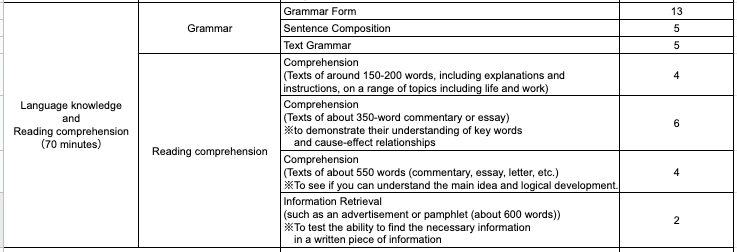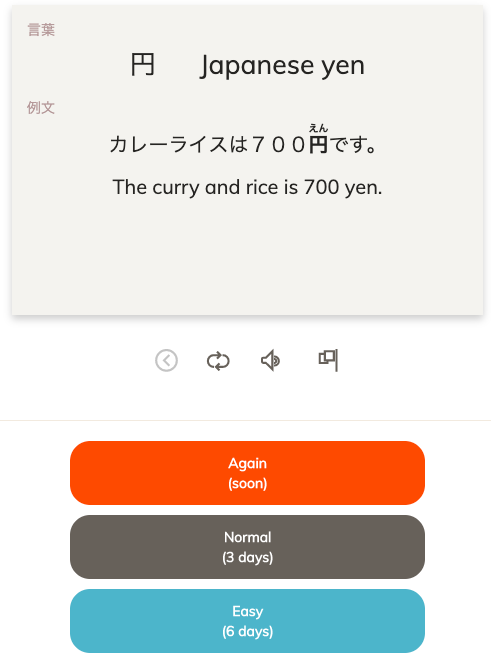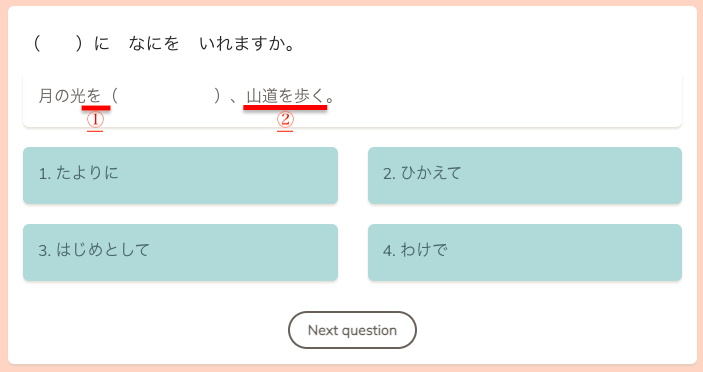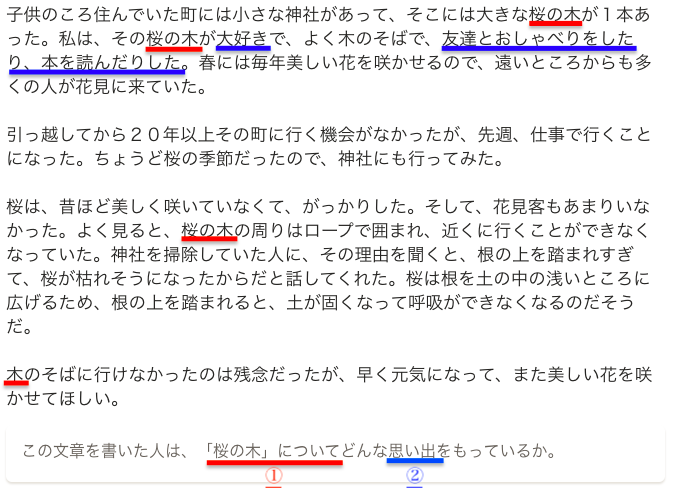Study tips to pass N3?
After having completed みんなの日本語 (Minna no Nihongo), what is your next goal? Based on the knowledge you gained through みんなの日本語 (Minna no Nihongo) journey, you should try to take the JLPT N3.
That is because the level above N3 is normally considered important in Japan, especially for the people who want to find a job. Of course, N2 or N1 will be needed to get a high-level job (trading company, consultant, embassy, etc…), but you can stand the start line if you pass N3.
Now, let’s get into the main topic!
When you start to study for N3, you will find out how many vocabularies, expressions and Kanji you should memorize. That’s why we highly recommend you analyze the test and know the most efficient way to achieve your goal.
First of all, Let’s take a look at the details of N3. 👇
JLPT N3 Exam Details
Pass score of JLPT N3
Not only do you have to get 95 points in total, but also you have to get the minimum score in each section.
Total Pass score:95 / 180
①Language knowledge:19 / 60
②Language knowledge and Reading comprehension:19 / 60
③Listening:19 / 60
Exam Coverage / Objective
The objective of the JLPT N3 is to understand the Japanese used in daily life to some extent. To be able to accompany the conversation between Japanese people, not only do you have to memorize as many vocabularies as possible, but also it is essential to get used to the nuance connoted in the statements.
However, this doesn’t mean you have to know all of the rules the Japanese people use in normal life. The test is created with some intentions by the professionals, which means if you know the right way to approach it, it will show you the path that leads you to the goal: “To pass JLPT N3 level”
In this section, let’s see the description of each part of the JLPT N3.
The test is divided into 3 parts ;
①【30 minutes】Letters & Vocabulary

②【70 minutes】Grammar and Reading comprehension

③【40 minutes】Listening

Total number of the questions
The total number of questions is “102” and the breakdown is as follows;
- 【35 questions】Letters & Vocabulary
- 【39 questions】Grammar and Reading comprehension
- 【28 questions】Listening
As I mentions above, you have to get the minimum score of each section so that you have the right to be evaluated in JLPT. Even though your score is more than 95 /180 (53%) in total, you can’t pass if you fail in any one of three sections.
19 / 60 equates to a score of approximately 32% for each section, and it would require you to answer correctly the following number of questions at least to be able to meet the minimum requirements to pass.
- 【12 / 35 questions】Letters & Vocabulary
- 【13 / 39 questions】Grammar and Reading comprehension
- 【10 / 28 questions】Listening
So, now let’s take a look at how to study efficiently to pass JLPT N3 in order to achieve 55 correct answers.👇
How to study efficiently for N3?
Think about time allocation
You can’t control the time allocation of Listening, but in the other two sections, you can!
Here are tips! By organizing your time allocation, when you don’t know the answer, you can easily move on to the next question in order to save you time. As you can see below, the questions of JLPT N3 have a big volume and you have to make a quick decision about what questions you have to answer and to abandon immediately.
- 【35 questions in 30 minutes】Letters & Vocabulary
- 【39 questions in 70 minutes】Language knowledge and Reading comprehension
- 【23 questions】Grammar
- 【16 questions】Reading comprehension
In the case of Letters & Vocabulary, try to choose the answer and mark it on the sheet within 50 seconds per question. In the first part of this section, you will find the questions easy, so solve them at a faster pace and leave more time for the later questions.
In the case of Grammar and Reading comprehension, it is more complicated because you will have to read the various length texts. Leaving a few minutes to review your answers, this time allocation is ideal.
【Reccomendation】66 minutes to answer all of the questions + 4 minutes to review them.
・23 Grammar questions =22 minutes in total
・4 Reading questions (text of 150〜200 words) =10 minutes in total
・6 Reading questions (text of 350 words) =16 minutes in total
・4 Reading questions (text of 550 words) =10 minutes in total
・2 Reading questions (Information retrieval) =8 minutes in total
Get to know the JLPT N3
★Learn vocabulary with an example sentence★
Accordingly to the description, as a basic requirement, you are expected to read kanji correctly and understand their meaning.
BUT, as I mentioned previously, what you have to do first before starting to learn is analyze the test and find an efficient study plan.
3 out of 5 descriptions don’t refer to the ability to read kanji correctly and understand their meaning, but the ability to find the usage of the kanji. This can’t be usually obtained if you only try to memorize the kanji through the question-and-answer method.
The efficient way to study is to learn vocabulary with an example sentence in order that you can check the usage of the kanji.
★【Grammar】Pay attention to the connections between the expressions★
At JLPT N3, you should learn approximately 130 sentence patterns. In the test, you have to choose an answer that matches the meaning of the sentence.
When studying, it is important to pay attention to which part of speech does it connect or whether it is followed by a sentence?
For example, in this case, the correct answer is “1. たよりに”. Even if you have chosen the correct answer, do not go straight to the next question. Please take a close look at the question and learn as much information as possible from it. If you continue to study in this way, you will learn more than one grammar point from each question. More than that, it saves you time!
- ①:「たよりに」is used with the particle “を”.
- ②:After「たよりに」, the sentence「山道(yamamichi)を歩(aru)く=walk on the mountain path」 comes.
★【Reading Comprehension】Read the question first!★
There is an important tip before reading the text. Read the question first! In the Reading section, comprehension is the main focus and it is critical for you to find a keyword/indicator in the text. When you take a look at the question first, it will show you where you have to pay attention.
The question is 「桜の木」についてどんな思い出をもっているか。, which means “What kind of memories does the author have about 「cherry blossom」?”. The key indicator is ① and ②, and you will know that you will have to find information about the cherry blossom and the memories. When we talk about memories, we are usually referring to the past. That’s why all you have to do is to find words related to ①cherry blossom and ②memories as shown in the example.
Conclusion
To sum up, tips to pass JLPT N3 and to study efficiently are as below.
- Check Pass score of N3 and calculate the number of questions you have to answer correctly.
- Think about the time allocation so that you make a quick decision in the case of not knowing the correct answer.
- Make a study plan and get to know the efficent way to study.
If you want to pass JLPT N3, we are always with you. Our Japanese learning platform offers you various learning FREE materials (N5〜N1), such as Dashboard to manage your study time, Flashcard for Word, Mini test, Lecture, and Training of Vocabulary&Grammar, Reading and Listening.
© 2021 GLOBAL ASTRA Inc. All Rights Reserved.

We offer the Best Online Japanese Learning (All Free), and our goal is to facilitate the adoption into life in Japan. Our service “IPPO” is made by native Japanese teachers and professionals. The tips we share with you can help you to learn Japanese efficiently and pass JLPT (Japanese Language Proficiency Test).






